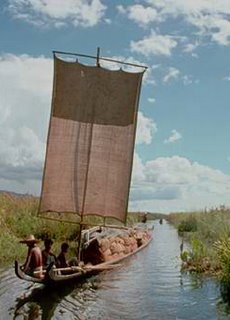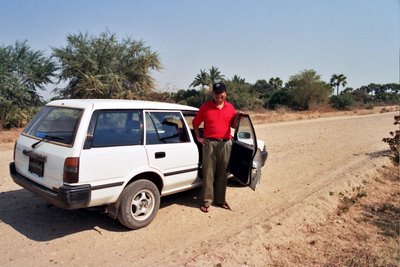
by Richard W. Wise
I Checked into an old hotel in the old part of downtown
My plan for a second visit to the ruby mining town of
We will take it easy and do the trip in three stages... The first day we will drive two hundred miles upcountry and stop in a small town at a hotel that Lwin knows well. The second stage, another five or six hours by car, will bring us to the ancient
The next morning promptly at nine, (Lwin) and his friend John, (a thin dark skinned missionary educated Burmese of about fifty with an excellent command of English) show up and we plan our itinerary. The only thing I don’t like is the return, four hundred miles from 
We spend the morning visiting  shaving of the pavilion, a small sacrifice of weight to sharpen the crystal and bring out the saturation it finished at 1.74 carats. Mong Hsu stones are often a purer red hue than old mine stones; the usual
shaving of the pavilion, a small sacrifice of weight to sharpen the crystal and bring out the saturation it finished at 1.74 carats. Mong Hsu stones are often a purer red hue than old mine stones; the usual  secondary hue is purple. Mogok rubies tend toward the pink. Another, a 1.36 carat round (pictured) was a real find. I found another, a 3.60 carat oval paradigm, one of the finest rubies I have ever seen. Perfection is expensive but I had to buy it.
secondary hue is purple. Mogok rubies tend toward the pink. Another, a 1.36 carat round (pictured) was a real find. I found another, a 3.60 carat oval paradigm, one of the finest rubies I have ever seen. Perfection is expensive but I had to buy it.
Natural color or burned (heat treated), rubies of fine color are extremely scarce, almost as rare as untreated. I must have closely examined over a hundred burned stones. In the ruby trading capital of the world, I saw almost nothing of fine color. One more stop and we see a few more rubies and a large sapphire. The sapphire color is good the lovely purplish blue “peacock” hue that
I return to the hotel for checkout. First stop a small local restaurant that Lwin favors. The restaurant located on a side street It has an front wall open to the street. It’s a little lacking in ambience, with plain well-scared wooden tables, serviceable chairs and no tourists, a restaurant in a garage. We amble up to the front counter that is set up sort of delicatessen style. With Lwin’s guidance I pick out my dishes. The place is bustling, people dressed in the traditional Longji with a western shirt or top, eating talking and generally having a good time.
Burmese cooking features a broad palette of herbs and spices. We try mint leaves, chili, lemon, and a saffron flavored curry all served over rice. Burmese food pleasantly hot but Lwin cautions, beware of the cute little green chilies, they can change your life.
Fuel, gasoline and diesel is rationed in
Well, its 2;00 PM., fed and fueled, off we go on the first leg of our trip along the road to
Driving the road requires a bit of etiquette. Compact cars going in opposite directions can pass each other, barely. But if you meet a lorry there is a delicate two-step that usually finds the smaller vehicle giving the most ground. Luckily outside the city, most of the traffic is made up of bicycles, trishaws and bullock carts.
The trishaw is a unique and interesting vehicle. It is basically a bicycle with a one-wheeled sidecar. It is the Burmese peasant’s answer to the family automobile. With a little planning it’ can carry five. Two in the sidecar, (wife facing front, mother-in-law facing rear); one child on the rear fender and another on the front handlebars. If you are a farmer, the bullock cart may be your vehicle of choice. Two yoked bullocks power this handmade wooden beauty. A bit slow off the line, it sports a five-foot wheelbase and can easily carry a large family and the family groceries. It’s a multi-purpose vehicle, sort of a third world SUV. When not in use carrying passengers it is perfect for off-road use (harvesting crops). It is easily navigable through all but the deepest rice paddies.
Lwin is the type of driver whose driving style would reduce a  journey I can recall only one instance when we were passed (a large bus on a dirt road). The rest of the time it was us passing them. The man is the Burmese version of a grand prix racer. I am sure we passed half the motorized vehicles in
journey I can recall only one instance when we were passed (a large bus on a dirt road). The rest of the time it was us passing them. The man is the Burmese version of a grand prix racer. I am sure we passed half the motorized vehicles in
Along many sections of the road huge ancient Acacia trees, dating from the days of the British Raj, form a canopy shading the road.. Rice appears to be the dominant crop and we pass field after field with rows upon row of tender green shoots.
Six hours later we pull up at a bungalow hotel in the small town of
l is situated on a small lake and we eat our dinner al fresco on a covered deck overlooking the water. The food is good; I have a chicken stir fry dish laced with cashews. The night is hot and sultry, the food delicately flavored. Burmese music blasts from a loudspeaker somewhere in the distance.
Like the blog? You will love the book!
"This book takes a much-needed sledgehammer to the industry's conventional wisdom about what makes a gemstone precious, and in the process builds a solid foundation for anyone who wants to understand the true beauty and value of gemstones."
Morgan Beard
Editor-in-Chief Colored Stone Magazine
Read a free chapter www.secretsofthegemtrade.com





1 comment:
A very good read, Richard. I especially enjoyed your relating about going through rubies to find one actually worth paying a lot of money for!
Post a Comment